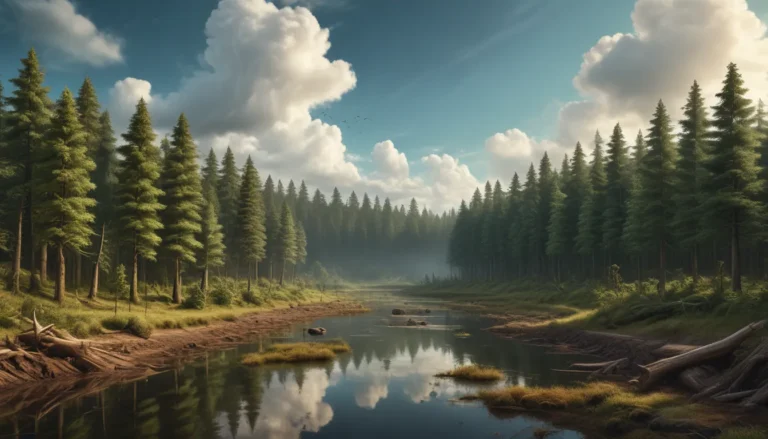A Note About Images: The images used in our articles are for illustration purposes only and may not exactly match the content. They are meant to engage readers, but the text should be relied upon for accurate information.
Welcome to the captivating world of geology, where the Earth’s hidden processes and structures come to light. One intriguing phenomenon that often goes unnoticed is “creep,” a slow and gradual movement of rocks and soil driven by the force of gravity. While not as dramatic as earthquakes or volcanic eruptions, creep plays a significant role in shaping our planet’s landscapes over time.
In this article, we will embark on a journey to uncover 12 extraordinary facts about creep in geology. From its causes and effects to its implications for both natural environments and human-made structures, we will delve into the fascinating dynamics of this geological process. So, buckle up and prepare to explore the intriguing world of creep in geology!
Understanding the Essence of Creep
- Creep is a slow, sneaky movement of soil and rocks influenced by gravity.
- It has been shaping the Earth for centuries, impacting where people live and creating unique landforms.
- Scientists continue to unravel the secrets of this intriguing geological process.
The Enigmatic Nature of Creep
Creep manifests as a gradual displacement of soil or rock mass over time, imperceptible to the naked eye. The creeping motion can be observed in various forms, such as the bending of tree trunks on slopes or the tilting of fence posts. This slow but continuous movement can have significant implications for the landscape and structures in its path.
The Impact of Creep on Structures and Infrastructure
The relentless movement of creep can exert immense pressure on structures and infrastructure, leading to structural deformations, cracks, and even collapse over time. Buildings, retaining walls, and highways are particularly vulnerable to the adverse effects of creep. Therefore, careful engineering and monitoring are crucial to mitigate potential risks and ensure the safety of these structures.
Factors Influencing Creep
The speed and magnitude of creep are influenced by various factors, including the angle of the slope and the composition of the underlying soil. Steep slopes and loose, granular soils are conducive to higher creep rates, while gentle slopes and cohesive soils may experience slower movements. Environmental factors such as freeze-thaw cycles and rainfall also play a significant role in initiating and accelerating creep.
The Formation of Unique Landforms
The continuous movement of creep over time can give rise to distinctive landforms, providing valuable insights into the geological history of an area. Terracettes, small step-like features that form on hillslopes due to downslope movement of soil or rock, are just one example of the fascinating landforms created by creep. These formations showcase the remarkable sculpting power of geological processes.
Creep Beyond the Surface
While creep is commonly associated with terrestrial landscapes, it also occurs in underwater environments. Submarine creep, the gradual displacement of sediment on the seafloor, can have significant implications for submarine cables, pipelines, and other offshore structures. Understanding and monitoring this phenomenon are essential for ensuring the stability of underwater infrastructure.
Creep’s Influence on Archaeological Sites
The slow movement of creep over time can impact archaeological sites, potentially altering the stability of ancient structures and compromising the preservation of artifacts. Archaeologists and heritage conservationists must consider the influence of creep when planning excavations and site maintenance to safeguard our historical heritage.
Monitoring and Mitigation Measures
Given the potential risks associated with creep, monitoring and mitigation measures are vital for managing its effects. Techniques like inclinometers, strain gauges, and remote sensing technologies enable the tracking of movement and identification of areas of concern. Engineering solutions such as retaining walls and ground reinforcement can be deployed to minimize the impact of creep on structures.
Creep and Natural Hazards
Creep is closely linked to other natural hazards, including landslides and earthquakes. The progressive deformation of slopes due to creep can increase the likelihood of slope failures, while fault adjustments through creep can contribute to seismic activity. Understanding these connections is essential for effective hazard assessment and mitigation strategies.
The Role of Creep in the Formation of Unique Rock Formations
Natural wonders like arches, hoodoos, and balanced rocks owe their existence in part to the long-term effects of creep. Over millions of years, the slow movement of rock layers has sculpted these awe-inspiring formations, showcasing the incredible power of geological processes in shaping our planet’s landscapes.
Creep’s Impact on Human History and Settlement Patterns
Creep has played a significant role in shaping human history by influencing settlement patterns and land use. Ancient civilizations often avoided areas prone to creep, recognizing the risks to infrastructure and livelihoods. Understanding the history and behavior of creep informs modern urban planning and infrastructure development practices.
The Pursuit of Knowledge: Ongoing Research in Creep
Despite significant advancements in our understanding of creep, there is still much to learn about its intricacies and interactions with other geological processes. Ongoing research endeavors seek to refine models, improve monitoring techniques, and enhance our ability to mitigate the effects of creep on the ever-changing landscape.
Conclusion: Unveiling the Enigma of Creep in Geology
Geological creep remains a fascinating phenomenon that quietly shapes our planet’s features over time. These extraordinary facts about creep underscore its importance in the Earth’s geology:
- Creep is a slow, continuous movement of soil and rocks influenced by gravity.
- It contributes to the formation of unique landforms and can cause significant damage to infrastructure.
- Understanding the factors influencing creep is essential for monitoring and mitigating its effects.
- Creep’s connections to natural hazards emphasize the importance of hazard assessment and mitigation strategies.
- Ongoing research in creep continues to expand our knowledge and improve our ability to manage this geological process effectively.
FAQs: Exploring Common Questions About Creep
-
What causes geological creep?
Geological creep is primarily caused by the force of gravity acting on solid materials, leading to slow and continuous movement over time. -
How does geological creep affect the Earth’s surface?
Geological creep has a profound impact on various geological features, shaping mountains, hillslopes, riverbeds, and creating unique landforms. -
Can geological creep be harmful?
Yes, geological creep can be harmful, especially in areas prone to landslides or where human activities have altered the natural landscape. It can cause damage to infrastructure over time. -
How do scientists study and monitor geological creep?
Scientists use various methods, including GPS monitoring, tiltmeters, and geological surveys, to study and monitor geological creep over time. -
Is geological creep a long-term process?
Yes, geological creep operates on geological timescales, with its effects often not immediately noticeable to humans but having substantial long-term impacts. -
What natural events can trigger or accelerate geological creep?
Natural events like earthquakes and heavy rainfall can trigger or accelerate geological creep processes, leading to significant movements in the Earth’s surface.
In conclusion, the intricate workings of geological creep offer a fascinating glimpse into the dynamic forces shaping our planet. By understanding and exploring the mysteries of creep, we gain valuable insights into our environment and the ongoing evolution of the Earth’s landscapes. Join us on this captivating journey of discovery as we unravel the enigma of creep in geology!
Was this information helpful?
Our dedication to delivering reliable and engaging content drives our commitment to providing you with accurate and insightful information. Each fact presented on our platform is contributed by real users, enriching our knowledge base with diverse perspectives and valuable insights. Trust in our dedication to quality and authenticity as you embark on a journey of discovery and learning with us.






